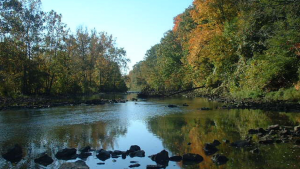During OSU Extension’s 2015 Annual Conference where educators, specialists, and program staff gathered across our four program areas, results of the Vice President’s Conversation on the Future of Extension were shared. Listed under Environment and Natural Resources was this: “responsible practices and a focus on sustainability related to water, air, energy development, soils, waste disposal, and agriculture.”
 This blog provides a description of a project that I have been involved with that implements the mission of the Land Grants as they address 2035 needs by taking research-based information through outreach to help community leaders and residents. What makes this project unique is it integrates the tremendous depth of interdisciplinary focus and collaboration offered within the Land Grant system.
This blog provides a description of a project that I have been involved with that implements the mission of the Land Grants as they address 2035 needs by taking research-based information through outreach to help community leaders and residents. What makes this project unique is it integrates the tremendous depth of interdisciplinary focus and collaboration offered within the Land Grant system.
Beginning over a year ago, this project’s focus was to improve drinking and recreational water quality in an Ohio metro area. The diversity of project partners included the private sector, OSU Extension, the OSU College of Food, Agricultural and Environmental Sciences, the OSU School of Environment and Natural Resources and the City.
- Engineering: A private engineering firm is under contract with the City Department of Water to evaluate and develop a plan to improve their drinking and recreational water quality. The firm is sub-contracting parts of the plan to OSU Extension and private consultants.
- Outreach: Extension’s role is to analyze agricultural management practices regarding nutrients and herbicides and develop strategies to improve water quality. To fulfill this role, the core OSU Team includes a CD Educator, a Faculty Emeritus, an Extension/SENR Program Specialist, and CD Unit office administrators. Extension is also working closely with another private sector sub-contractor whose role is to analyze and make recommendations regarding natural resource strategies to improve water quality.
- Research: CFAES, SENR, USDA/Agricultural Research Service and the Department of Food, Agricultural and Biological Engineering researchers contributed information and data regarding alternative management practices and their effects on water quality.
- Municipality: City employees in the Department of Public Utilities review and comment on strategies presented by the Engineer, OSU Extension and other sub-contractors. When the project is completed, the City will take on its implementation.
The depth of interdisciplinary focus and collaboration was critical to the success of this project. The Extension Team identified the potential agricultural areas of concern based on research studies conducted by departmental faculty. Additionally, this faculty identified potential management practices leading to the development of strategies to address these concerns.
ANR Field Specialists assisted in understanding researcher’s studies, more deeply identifying issues, capturing current educational practices and initiatives, and identifying current agricultural management practices being used by agricultural producers.
The 2015 Conservation Tillage and Technology Conference, led by an Emeritus Ag Engineer and County Extension Educators, was extremely valuable in helping the Extension Team understand the complicated relationships between water quality and agricultural practices. It also helped in connecting with the key players in the agriculture industry, including producers, researchers and Certified Crop Advisors. Throughout the project, both Field Specialists and County Educators helped the Extension Team think through specific questions raised by the Engineer and the City and provide data to help with the Engineer’s water quality modeling.
Throughout the project, progress meetings were held with the City and the engineer. The City provided feedback that focused the Extension Team’s work. The Extension Team has helped the City and Engineering firm adjust perceptions about the nutrient topic leading to a better understanding of agricultural producers’ needs and current changes in practices. We also provided some planning techniques and tools that the Engineering firm is using within the planning reports.
The Engineering firm concludes that this project provides a program design that many municipalities are going to use in the future to address their water quality issues.
We believe this project effectively demonstrates the results of a Land Grant’s mission when we integrate research, outreach and partnering across disciplines. As Extension uses this interdisciplinary approach, we will be successful in implementing initiatives that will provide what Ohioans will need to thrive in 2035.
(Submitted by Myra Moss, Associate Professor and Extension Educator, Heart of Ohio EERA)